Ques 81. The Brushes on DC machine are always placed on ______ in order to achieve sparkles commutation?
- MNA
- GNA
- Either GNA or MNA
- None of the above
Answer 1. MNA Explanation:- Armature reaction occurs in DC motors and is caused by the stator magnetic field being distorted, or altered, in reaction to the armature magnetic field. The armature reaction is actually a bending of the motor magnetic field so that the brushes are no longer aligned with the neutral magnetic plane of the motor. The figure depicts a two-pole generator whose field winding is excited and the direction of the magnetic flux is shown. Note that the flux distribution is uniform. Vector OFM represents the main field. It is observed that the MNA(Magnetic Neutral axis) which is always perpendicular to the field and GNA (Geometrical Neutral Axis) coincide with each other. The second figure shows an armature connected to a load and armature current flowing through the armature conductors. This armature current produces its own magnetic field. The vector OFA represents the armature field. In general, the MNA shifts in the direction of the motion in a generator and in the opposite direction of the motion in a motor. So, in a generator, armature coils undergoing commutation are under the influence of the backward pole. This produces dynamically induced emf in the coils due to the cutting of the flux along the brush axis, which will try to maintain the current in the original direction. In the case of a motor, the coils are under the influence of forward poles. Therefore, there will also be dynamically induced emf in the coils. The extent of MNA shift depends on the value of armature current and hence on the load of the machine. We know that the commutator must short out the armature coils just at the moment when the voltage across them is zero. When the machine is loaded and the MNA shifts, the brushes short out the coils with some voltage in them. Therefore heavy sparking occurs as the brushes leave a segment. This is a very serious problem as it reduces the brush life and causes pitting of the commutator segments. Moreover, the MNA shift can also lead to flashover in the commutator bars near the brushes. Air near the brushes in the machine is normally ionized when sparking at the brushes happens. Flashover occurs when the voltage of the adjacent commutator bars is large enough to sustain an arc. If a flashover occurs, the resulting arc can melt the surface of the commutator and cause severe pitting on the commutator surface. Hence the brushes are shifted from the mechanical neutral plane in a direction opposite to the rotation to reduce sparking.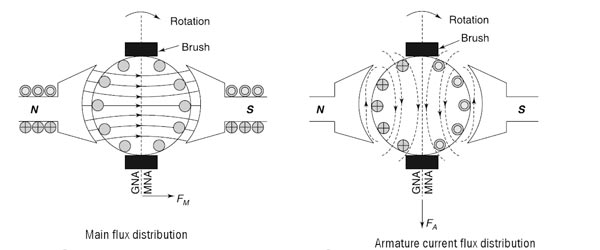
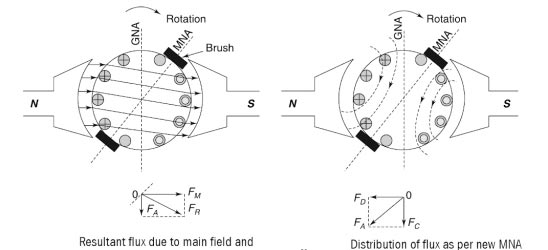

This armature flux interacts with the main flux and a resultant field is produced in the armature as shown in Fig. It can be seen from the figure that the resultant flux is not uniform. It is concentrated at the trailing tips of the pole and is rare (weak) at the leading pole tips. The resultant flux is shown by vector OFR which is the vector sum of OFM and OFA.
Ques82. If a DC series motor is made to run on an AC supply. It will
- Have no effect on efficiency
- Spark in excess but will not affect the efficiency
- Spark excessively and have poor efficiency
- Have poor efficiency
Answer 2. Excessively and have poor efficiency Explanation:-Series Connection:
where k = number of poles and the number of turns in the winding.
Φ = flux per pole
i = current.
Therefore, Torque = k × Ia2Parallel connection:
Ques 83. A 220 V, 15 kW, 1000 RPM Shunt Motor with an armature resistance of 0.25Ω, has a rated line current of 68 A and a rated field current of 2.2 A. The change in field flux required to obtain a speed of 1600 RPM while drawing a line current of 52.8 A and a field current of 1.8 A is
- 18.18% Increase
- 18. 18% decrease
- 36.36 % increase
- 36. 36 % decrease
Answer. 4. 36.36% decrease Explanation:- Given Data Supply Voltage V = 220 V The Line current of DC shunt motor is the sum of Armature current and Shunt field current IL = Ia + Ish ∴ Ia = IL − Ish Ia1 = 68 − 2.2 = 65.8 A From the voltage equation, the Back EMF will be Eb1 = V − Ia1Ra = 220 × 65.8 × 0.25 Eb1 = 203.55 Similarly for the line current of 52.8 A and a field current of 1.8 A the armature current will be Ia2 = 52.8 − 1.8 = 51 A Hence Eb2 = V − Ia2Ra = 220 × 51 × 0.25 Eb2 = 207.25 Let the on load speed be N. As we know that back EMF of DC motor is directly proportional to the flux and speed. Eb ∝ Nφ $\begin{array}{l}\dfrac{{{E_{b1}}}}{{{E_{b2}}}} = \dfrac{{{N_1}}}{{{N_2}}} \times \dfrac{{{\Phi _1}}}{{{\Phi _2}}}\\\\\dfrac{{203.55}}{{207.25}} = \dfrac{{1000}}{{1600}} \times \dfrac{{{\Phi _1}}}{{{\Phi _2}}}\\\\\dfrac{{{\Phi _2}}}{{{\Phi _1}}} = 0.6364\\\\\therefore \% {\text{ Decrease = }}\dfrac{{{\Phi _1} – {\Phi _2}}}{{{\Phi _1}}} \times 100\\\\ = 1 – \dfrac{{{\Phi _2}}}{{{\Phi _1}}} = 1 – 0.6364\\\\ = 0.3636 \times 100 = 36.36\end{array}$
Speed N1 = 1000 RPM
Armature Resistance Ra = 0.25 Ω
Line Current IL = 68A & 52.8A
Field current IF = 2.2 A & 1.8 A
Speed N2 = 1600 RPM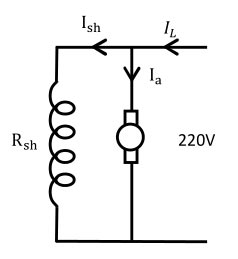
Ques 84. The demand for a large increase in torque of a d.c. shunt motor is met by
- Large decrease in speed
- Large increase in speed
- Large increase in current
- Small increase in current
Answer 3. Large increase in the current Explanation:- For a d.c. motor, Ta ∝ φ.Ia But in a shunt motor, φ is practically constant so that Ta ∝ Ia. So to increase the torque in DC shunt motor we must have to increase the Armature current.
Ques 85. _______ motors never use belt-connected loads.
- Series
- Shunt
- Cumulatively compounded
- Differentially compounded
Answer 3. Series Explanation:- Series motor is never used for the belt connected load because If the belt is accidentally broken, the motor will run on no-load. The flux drops to practically zero and the motor speed may become dangerously high. For this reason, a d.c. series motor is used only where the load is directly connected to the shaft or geared to the shaft.
Ques 86. A cumulatively compounded motor does not run at dangerous speed at light loads because of the presence of
- Compensating Winding
- Interpoles
- Shunt winding
- Series winding
Answer 3. Shunt Winding Explanation:- Compound-wound motors are used whenever it is necessary to obtain speed regulation and torque characteristics not obtainable with either a shunt or a series motor because many drives need a fairly high starting torque and a constant speed under load the compound wound motor is suitable for these applications. Some of the industrial applications include drives for passenger and freight elevators, stamping presses, rolling mills, and metal shears. Cumulative compounding combines the characteristics of both series and shunt motors. Compound motors have both shunt and series field windings installed on the same poles. Series windings may be differentially or cumulatively compounded. Subtracting from or adding to the magnetizing force of the shunt field causes either reduced or increased armature speed with load. Cumulative compounding gives greater torque than possible with a simple shunt motor because of the greater amount of main field flux available. Increased flux causes the speed to drop off more rapidly than for the shunt motor but not as much as for the series motor. The cumulative compound motor will develop high torque with any sudden increase in load. At light loads, the motor will not run away because the shunt field provides constant field flux. Cumulative compound motors are often applied to loads requiring high starting torque and fairly constant operating speed under normal conditions.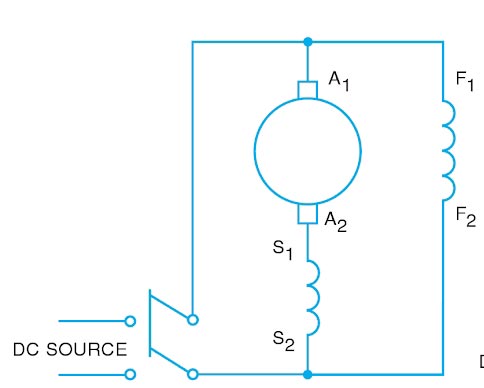
Ques 86. _______ motor is most suitable for punch presses.
- Shunt
- Series
- Differentially compounded
- Cumulatively compounded
Answer.4. Cumulative compounded Compound motors are used to drive machines that require a relatively constant speed under varying loads. They are frequently used on machines that require the application of heavy loads for very short periods of time, such as presses, shears, compressors, reciprocating tools, and elevators. Compound motors are also used when it is desired to protect the motor by causing it to decrease in speed under heavy loads.
Ques 87. The friction and windage losses in a d.c. motor depends upon ______
- Speed
- Flux
- Armature current
- Field and armature resistance
Answer 1. Speed Explanation:- As we know that in a DC machine, mechanical energy is converted into electrical energy. During the process of conversion, the total input power is not transformed into output power. Some part of input power gets wasted in various forms. These losses give in rise to the temperature of the machine and reduce its efficiency of the machine. For any dc. machine whether it is a generator or a motor, its efficiency is important It should work efficiently. This means that the losses must be as small as possible in d.c machines. The losses will determine the heating of the machine and hence the rating or power output that can be obtained without insulation failure. The various tests are performed to obtain information about the various losses taking place in a d.c machine. Losses in DC machine cause 2 main effect:- However, losses cannot be eliminated completely. They can only be reduced to some acceptable level using proper design. The various losses in a d.c. the machine, whether it is a motor or a generator, is categorized amplified into three groups as: These losses are produced due to friction and windage (friction with air) caused by machine rotation. Hence, these are named mechanical losses. Some power is required to overcome mechanical friction and wind resistance at the shaft. They depend on the speed of the machine. The mechanical losses are also constant for a d.c. machine Bearing friction loss generally depends on the type of bearing used and on the viscosity of the lubricant. Brush friction loss is proportional to the contact area and the brush pressure. It also depends on other factors like the material of the brush and commutator, their polish condition, and the temperature at the contact surface.
Losses in a D.C. Machine
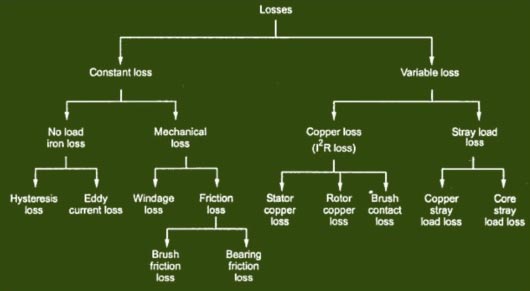
Mechanical Losses
Ques 88. The iron losses in a d.c motor depend upon ______
- Flux only
- Speed only
- Both flux and speed
- None of the above
Answer 3. Both flux and Speed Explanation:- Core losses are also known as iron losses or Magnetic losses. These Losses are constant and independent of the load. They are induced in the machine due to hysteresis and eddy currents produced in the core produced when the magnetization is changing. They mainly occur in the armature teeth and core as also in the pole shoe. Hysteresis losses occur due to the reversal of the magnetization of armature core. So, the hysteresis loss can be obtained as: Hysteresis Loss = Kh × BM1.67 × f × v watts where The eddy current loss exists due to eddy currents. When armature core rotates, it cuts the magnetic flux and e.m.f. gets induced in the core. This induced e.m.f. sets up eddy currents which cause the power loss. This loss is given by, Eddy current losses = Ke × Bm2 × f2 × t2 Where Ke = Eddy current constant Hence from the above equation flux is dependent on the square of the excitation flux, which determines magnetic induction. In addition, the losses are dependent upon the speed of rotation because the field pulsates with respect to the iron sheets with a frequency that is equal to the angular speed of the rotor. The iron losses within the rotor are denoted by PFe. They exist even in cases when the armature winding is disconnected and does not have any current.Core Losses
Kh = Hysteresis constant depends upon the material
Bm = Maximum flux density
f = frequency
v = Volume of the core
t = thickness of the core
Ques 89. The greatest percentage of power loss in a d.c motor is due to ______
- Windage loss
- Copper loss
- Core loss
- Friction loss
Answer 2. Copper loss Explanation:- For a DC Machine, Total Losses = Constant losses + Variable losses Constant losses are those losses which always occur irrespective of the load conditions and whose value remains constant for a given machine. Mechanical losses, core losses and shunt field copper losses are included in constant losses. Variable losses are those losses which increase as the load on the machine is increased. They are electrical losses including armature copper losses, field winding copper losses, interpole winding copper losses, compensating winding copper losses and brush contact losses. Copper losses increase proportionally to the square of the armature current while brush contact losses increase proportional to armature current. These losses are about 30% of the total full load losses.Constant and Variable Losses
Ques 90. A motor takes a large current at starting because
- Shunt field is producing the weak field
- The armature resistance is high
- Back e.m.f. is low
- None of the above
Answer.3. Back E.M.F is low Explanation:- The Voltage equation of DC Motor is given by V = Eb + IaRa Where, V is the supply voltage, Ia is the armature current, Ra is the armature resistance. And the back emf is given by Eb. Now the back emf, in case of a DC motor, is very similar to the generated emf of a DC generator as it’s produced by the rotational motion of the current carrying armature conductor in presence of the field. This back emf of DC motor is given by ${E_b} = \dfrac{{P\Phi ZN}}{{60A}}$ Where P – Number of poles of the machine ϕ – Flux per pole in Weber. Z – Total number of armature conductors. N – Speed of armature in revolution per minute (r.p.m). A – Number of parallel paths in the armature winding. From this equation, we can see that Eb is directly proportional to the speed N of the motor. Now since at starting N = 0, Eb is also zero, and under this condition, the voltage equation is modified to V = 0 + IaRa Ia = V/Ra For all practical practices to obtain optimum operation of the motor the armature resistance is kept very small usually in the order of 0.5 Ω − 0.10Ω and the bare minimum supply voltage being 240 volts. Even under this circumstance the starting current, Ia is as high as 240/0.5 amp = 480 amp.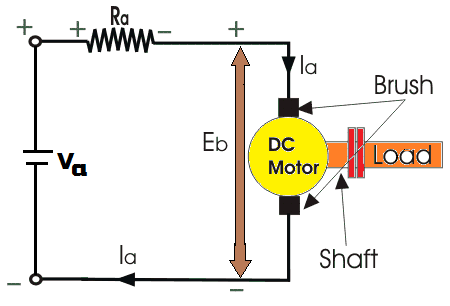
Such high starting current of DC motor creates two major problems.



